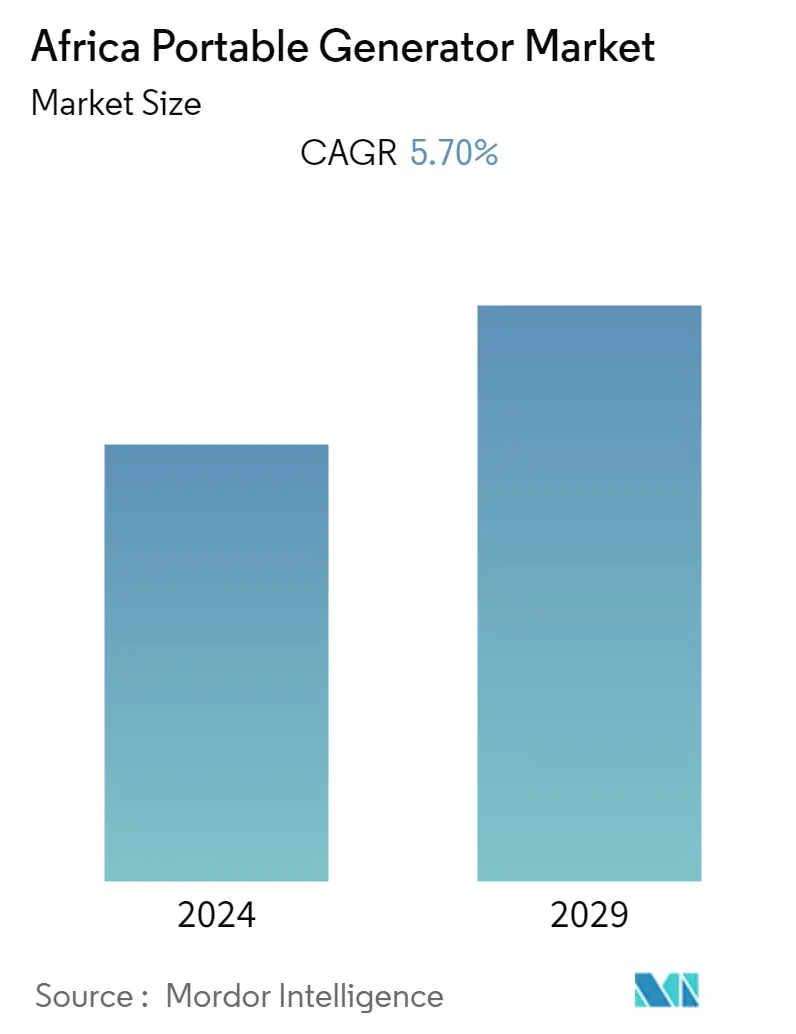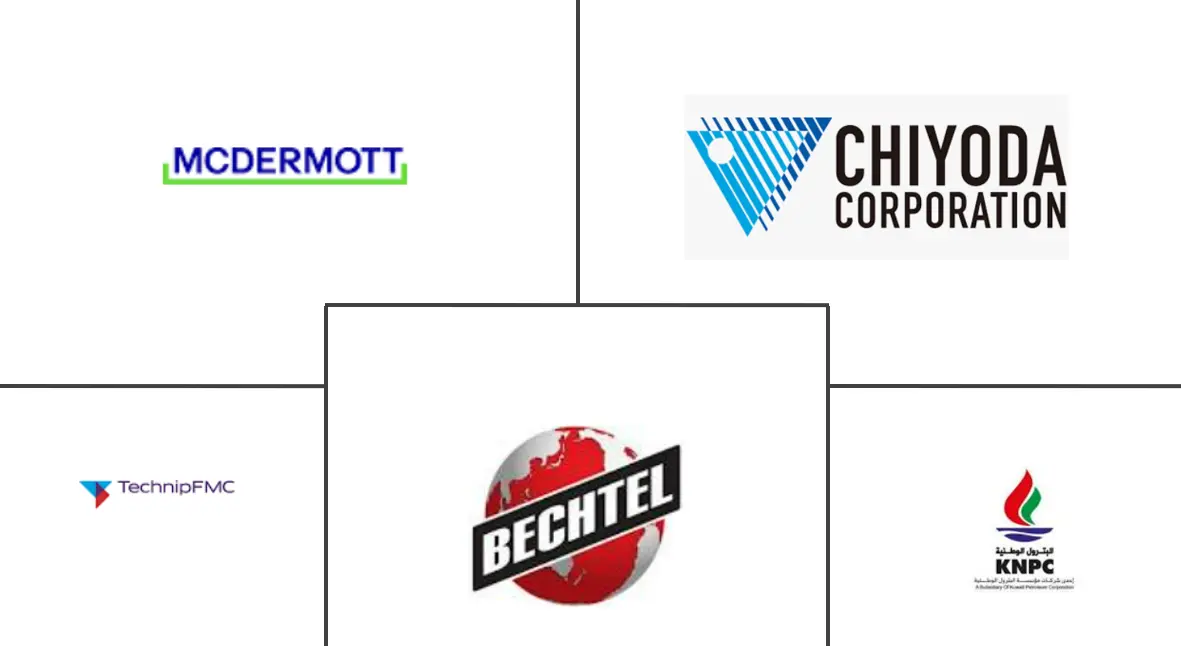Market Size of Africa Portable Generator Industry

| Study Period | 2019 - 2029 |
| Base Year For Estimation | 2023 |
| Forecast Data Period | 2024 - 2029 |
| Historical Data Period | 2019 - 2022 |
| CAGR | 5.70 % |
| Market Concentration | Medium |
Major Players
*Disclaimer: Major Players sorted in no particular order |
Africa Portable Generator Market Analysis
The Africa Portable generator market is projected to register a CAGR of over 5.7% during the forecast period.
The market was negatively impacted by COVID-19 in 2020. Presently the market has now reached pre-pandemic levels.
- Power outages and off-grid applications to increase the demand for portable generators in the forecast period.
- Geopolitical tensions and their impact on imports and prices are one of the major restraints for the market.
- The development of hybrid renewable energy systems is expected to be a significant growth opportunity for the generator set market during the forecast period.
- Nigeria region dominates the market and is also likely to witness the highest CAGR during the forecast period. Nigeria's one of the largest economies where businesses rely mainly on generators. According to the Central Bank of Nigeria (CBN), as of 2021, Nigerians spend an estimated USD 14 billion on generators and fuel yearly to prevent their businesses from crippling.
Africa Portable Generator Industry Segmentation
A generator set typically consists of an engine, and a generator mounted together as a single unit. In certain applications, a generator set may include other components, such as a fuel container, voltage regulator, or inverter. The primary function of the set is for the electrical generator to convert mechanical energy from the engine into electrical energy. The Portable generator market is segmented by capacity, end user, fuel type, and region. By capacity, the market is segmented into below 5 kW, 5-10 kW, and Above 10 kW. By fuel type, the market is segmented into gas, diesel, and other fuel types. By end user, the market is segmented into residential, commercial, and industrial. The report also covers the market size and forecasts for the portable generator market across major regions. For each segment, the market sizing and forecasts have been done based on revenue (USD Billion).
| Capacity | |
| Below 5 kW | |
| 5-10 kW | |
| Above 10 kW |
| End User | |
| Residential | |
| Commercial | |
| Industrial |
| Fuel Type | |
| Gas | |
| Diesel | |
| Other Fuel Types |
| Geography | |
| Nigeria | |
| South Africa | |
| Algeria | |
| Kenya | |
| Rest of Africa |
Africa Portable Generator Market Size Summary
The Africa portable generator market is experiencing a resurgence, having rebounded to pre-pandemic levels after the setbacks caused by COVID-19. The demand for portable generators is driven by frequent power outages and the need for off-grid power solutions, particularly in regions like Nigeria, where the economy heavily relies on these devices due to inadequate grid infrastructure. Diesel generators, known for their reliability and cost-effectiveness, are predominantly used as standby power sources across residential, industrial, and commercial sectors. Despite the higher cost of diesel compared to other fuels, its energy density and safety advantages make it a preferred choice. The market is also witnessing a growing interest in hybrid renewable energy systems, which present significant growth opportunities, although geopolitical tensions and import challenges pose potential restraints.
The market landscape is characterized by a fragmented structure with key players such as Mitsubishi Heavy Industries, Atlas Copco AB, Denyo Co., Ltd, Kirloskar Oil Engines Ltd, and Cummins Inc. These companies are innovating to meet the evolving demands, with recent developments like Kirloskar Oil Engines' launch of IoT-enabled gas generators that offer real-time performance monitoring and reduced emissions. Government initiatives in countries like Nigeria aim to increase renewable energy adoption, which could impact the generator market. However, the persistent electricity access issues in Sub-Saharan Africa, particularly in rural areas, continue to drive the demand for portable generators. The industrial sector's growth, fueled by investments and improved business conditions, is expected to further boost the market, especially for high-power gas generators.
Africa Portable Generator Market Size - Table of Contents
-
1. MARKET OVERVIEW
-
1.1 Introduction
-
1.2 Market Size and Demand Forecast in USD billion, till 2027
-
1.3 Recent Trends and Developments
-
1.4 Government Policies and Regulations
-
1.5 Market Dynamics
-
1.5.1 Drivers
-
1.5.2 Restraints
-
-
1.6 Supply Chain Analysis
-
1.7 Porter's Five Force Analysis
-
1.7.1 Bargaining Power of Suppliers
-
1.7.2 Bargaining Power of Consumers
-
1.7.3 Threat of New Entrants
-
1.7.4 Threat of Substitutes Products and Services
-
1.7.5 Intensity of Competitive Rivalry
-
-
-
2. MARKET SEGMENTATION
-
2.1 Capacity
-
2.1.1 Below 5 kW
-
2.1.2 5-10 kW
-
2.1.3 Above 10 kW
-
-
2.2 End User
-
2.2.1 Residential
-
2.2.2 Commercial
-
2.2.3 Industrial
-
-
2.3 Fuel Type
-
2.3.1 Gas
-
2.3.2 Diesel
-
2.3.3 Other Fuel Types
-
-
2.4 Geography
-
2.4.1 Nigeria
-
2.4.2 South Africa
-
2.4.3 Algeria
-
2.4.4 Kenya
-
2.4.5 Rest of Africa
-
-
Africa Portable Generator Market Size FAQs
What is the current Africa Portable Generator Market size?
The Africa Portable Generator Market is projected to register a CAGR of 5.70% during the forecast period (2024-2029)
Who are the key players in Africa Portable Generator Market?
Mitsubishi Heavy Industries, Atlas Copco AB, Denyo Co., Ltd,, Kirloskar Oil Engines Ltd and Cummins Inc. are the major companies operating in the Africa Portable Generator Market.

